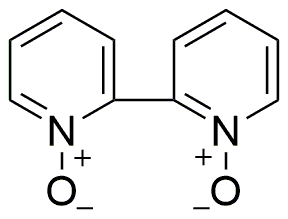2,2'-Bipyridyl 1,1'-dioxide is widely utilized in research focused on:
- Catalysis: This compound serves as a ligand in various catalytic processes, enhancing the efficiency of reactions in organic synthesis, particularly in transition metal catalysis.
- Coordination Chemistry: It is commonly used to form stable complexes with metals, which are essential in developing new materials and studying electronic properties.
- Analytical Chemistry: The compound acts as a chelating agent, improving the detection and quantification of metal ions in environmental samples, making it valuable for researchers in environmental science.
- Pharmaceutical Development: Its unique properties allow it to be explored in drug formulation, particularly in enhancing the solubility and bioavailability of active pharmaceutical ingredients.
- Material Science: The compound is investigated for its potential in creating advanced materials, such as sensors and electronic devices, due to its electronic and optical properties.
General Information
Properties
Safety and Regulations
Applications
2,2'-Bipyridyl 1,1'-dioxide is widely utilized in research focused on:
- Catalysis: This compound serves as a ligand in various catalytic processes, enhancing the efficiency of reactions in organic synthesis, particularly in transition metal catalysis.
- Coordination Chemistry: It is commonly used to form stable complexes with metals, which are essential in developing new materials and studying electronic properties.
- Analytical Chemistry: The compound acts as a chelating agent, improving the detection and quantification of metal ions in environmental samples, making it valuable for researchers in environmental science.
- Pharmaceutical Development: Its unique properties allow it to be explored in drug formulation, particularly in enhancing the solubility and bioavailability of active pharmaceutical ingredients.
- Material Science: The compound is investigated for its potential in creating advanced materials, such as sensors and electronic devices, due to its electronic and optical properties.
Documents
Safety Data Sheets (SDS)
The SDS provides comprehensive safety information on handling, storage, and disposal of the product.
Product Specification (PS)
The PS provides a comprehensive breakdown of the product’s properties, including chemical composition, physical state, purity, and storage requirements. It also details acceptable quality ranges and the product's intended applications.
Certificates of Analysis (COA)
Search for Certificates of Analysis (COA) by entering the products Lot Number. Lot and Batch Numbers can be found on a product’s label following the words ‘Lot’ or ‘Batch’.
Numéro de catalogue
Numéro de lot/série
Certificates Of Origin (COO)
This COO confirms the country where the product was manufactured, and also details the materials and components used in it and whether it is derived from natural, synthetic, or other specific sources. This certificate may be required for customs, trade, and regulatory compliance.
Numéro de catalogue
Numéro de lot/série
Safety Data Sheets (SDS)
The SDS provides comprehensive safety information on handling, storage, and disposal of the product.
DownloadProduct Specification (PS)
The PS provides a comprehensive breakdown of the product’s properties, including chemical composition, physical state, purity, and storage requirements. It also details acceptable quality ranges and the product's intended applications.
DownloadCertificates of Analysis (COA)
Search for Certificates of Analysis (COA) by entering the products Lot Number. Lot and Batch Numbers can be found on a product’s label following the words ‘Lot’ or ‘Batch’.
Numéro de catalogue
Numéro de lot/série
Certificates Of Origin (COO)
This COO confirms the country where the product was manufactured, and also details the materials and components used in it and whether it is derived from natural, synthetic, or other specific sources. This certificate may be required for customs, trade, and regulatory compliance.


